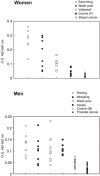Physical activity and natural anti-VIP antibodies: potential role in breast and prostate cancer therapy
- PMID: 22140573
- PMCID: PMC3227651
- DOI: 10.1371/journal.pone.0028304
Physical activity and natural anti-VIP antibodies: potential role in breast and prostate cancer therapy
Abstract
Background: There is convincing evidence from numerous clinical and epidemiological studies that physical activity can reduce the risk for breast and prostate cancer. The biological mechanisms underlying this phenomenon remain elusive. Herein we suggest a role for naturally produced antibodies reactive with the vasoactive intestinal peptide (VIP) in the suppression of breast and prostate cancer, which we believe could offer a possible molecular mechanism underlying control of these cancers by physical exercise.
Methodology and results: We found that sera from individuals having breast and prostate cancers have decreased titers of VIP natural antibodies as demonstrated by a lower reactivity against peptide NTM1, having similar informational and structural properties as VIP. In contrast, sera collected from elite athletes, exhibited titers of natural NTM1-reactive antibodies that are significantly increased, suggesting that physical activity boosts production of these antibodies.
Significance: Presented results suggest that physical exercise stimulates production of natural anti-VIP antibodies and likely results in suppression of VIP. This, in turn, may play a protective role against breast and prostate cancers. Physical exercise should be further investigated as a potential tool in the treatment of these diseases.
Conflict of interest statement
Figures

Similar articles
-
Can natural antibodies to VIP or VIP-like HIV-1 glycoprotein facilitate prevention and supportive treatment of breast cancer?Med Hypotheses. 2011 Sep;77(3):404-8. doi: 10.1016/j.mehy.2011.05.030. Epub 2011 Jun 17. Med Hypotheses. 2011. PMID: 21684085
-
Natural autoantibodies in healthy neonatals recognizing a peptide derived from the second conserved region of HIV-1 gp120.Vojnosanit Pregl. 2014 Apr;71(4):352-61. doi: 10.2298/vsp1404352d. Vojnosanit Pregl. 2014. PMID: 24783415
-
Expression of vasoactive intestinal peptide and functional VIP receptors in human prostate cancer: antagonistic action of a growth-hormone-releasing hormone analog.Int J Oncol. 2005 Jun;26(6):1629-35. doi: 10.3892/ijo.26.6.1629. Int J Oncol. 2005. PMID: 15870879
-
Monoclonal antibodies against vasoactive intestinal polypeptide: studies of structure and related antigens.J Neurochem. 1983 Aug;41(2):549-55. doi: 10.1111/j.1471-4159.1983.tb04774.x. J Neurochem. 1983. PMID: 6875552
-
Binding and multiple hydrolytic sites in epitopes recognized by catalytic anti-peptide antibodies.Ciba Found Symp. 1991;159:156-67; discussion 167-73. doi: 10.1002/9780470514108.ch11. Ciba Found Symp. 1991. PMID: 1720373 Review.
Cited by
-
Increased ARPP-19 expression is associated with hepatocellular carcinoma.Int J Mol Sci. 2014 Dec 24;16(1):178-92. doi: 10.3390/ijms16010178. Int J Mol Sci. 2014. PMID: 25547487 Free PMC article.
References
-
- Gespach C, Bawab W, Chastre E, Emami S, Yanaihara N, et al. Pharmacology and molecular identification of vasoactive intestinal peptide (VIP) receptors in normal and cancerous gastric mucosa in man. Biochemical and biophysical research communications. 1988;151:939–947. - PubMed
-
- Moody TW, Leyton J, Gozes I, Lang L, Eckelman WC. VIP and breast cancer. Annals of the New York Academy of Sciences. 1998;865:290–296. - PubMed
-
- Madsen B, Georg B, Madsen MW, Fahrenkrug J. Downregulation of VPAC1R expression in breast cancer cell lines. Annals of the New York Academy of Sciences. 2000;921:33–36. - PubMed
-
- Gespach C, Bawab W, de Cremoux P, Calvo F. Pharmacology, molecular identification and functional characteristics of vasoactive intestinal peptide receptors in human breast cancer cells. Cancer research. 1988;48:5079–5083. - PubMed
-
- Dagar S, Sekosan M, Rubinstein I, Onyuksel H. Detection of VIP receptors in MNU-induced breast cancer in rats: implications for breast cancer targeting. Breast cancer research and treatment. 2001;65:49–54. - PubMed
Publication types
MeSH terms
Substances
LinkOut - more resources
Full Text Sources
Medical

